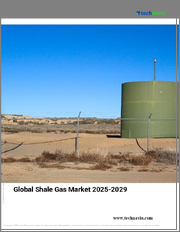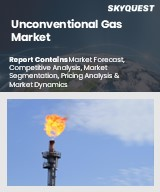
|
시장보고서
상품코드
1611752
세계의 셰일 가스 시장 - 규모, 점유율, 동향 분석 보고서 : 용도별, 지역별, 부문 예측(2025-2030년)Shale Gas Market Size, Share & Trends Analysis Report By Application (Aerospace & Defense, Medical, Automotive, Consumer Products & Industrial, Others), By Region (North America, RoW), And Segment Forecasts, 2025 - 2030 |
||||||
셰일가스 시장의 성장과 동향
Grand View Research, Inc.의 최신 보고서에 따르면 세계 셰일 가스 시장 규모는 2025-2030년에 걸쳐 CAGR 5.9%를 기록하며, 2030년에는 1,278억 달러에 이를 전망입니다.
일부 최종 용도에서 보다 깨끗한 연소 에너지원에 대한 수요 증가는 예측 기간 동안 시장을 견인할 가능성이 높습니다.
셰일가스(혈암층에 갇힌 천연가스)의 수익성이 높은 생산은 접근가능한 수요에 의존하고 있습니다. 기술적 특성을 가지고 있으며, 건축열부문, 산업열부문, 발전부문에 용도를 발견하고 있습니다.
셰일 가스는 발전에 많은 에너지를 공급하고 있으며, 세계 발전에 있어서의 에너지 공급의 점유율에서는 석탄에 이어 2위입니다. 이에 대응하여 향후 수십 년에 걸쳐 확대될 것으로 예상됩니다.
셰일 가스 공급망에는 생산과 가공, 가스의 트랜스미션과 저장, 시티게이트, 대구고객, 주택고객, 상업고객에게의 배급이 포함됩니다. 셰일 가스의 경제적 생산이 촉진되고 공급망의 업스트림 부문이 강화될 것으로 기대됩니다.
셰일 가스 시장 보고서 하이라이트
- 북미는 2024년 최대 시장 수익 점유율을 차지했으며 미국은 이 지역 시장에 크게 기여하고 있습니다. 풍부한 셰일 가스 매장량과 첨단 드릴링 기술의 개발이 산업 성장에 영향을 미치는 주요 요인 중 하나입니다.
- 중국의 잠재적인 셰일가스 자원은 매장량에서 비재래형 가스를 추출 및 생산하기 위해 세계 주요 시장 진출 기업으로부터 거액의 투자를 모으고 있습니다.
- 발전 부문은 시장을 독점하고 석탄에서 가스로 발전소의 천연 가스 수요 증가로 2024년에는 27.4%의 최대 수익 점유율을 차지했습니다.
- 운송 부문은 자동차 산업 전반에 걸쳐 압축 천연 가스(CNG) 연료 차량의 수가 증가했기 때문에 현저한 CAGR을 나타낼 것으로 추정됩니다.
목차
제1장 조사 방법과 범위
제2장 주요 요약
제3장 셰일가스 시장의 변수, 동향, 범위
- 세계의 셰일 가스 시장 전망
- 산업 밸류체인 분석
- 기술 개요
- 평균 가격 동향 분석
- 수급 격차 분석, 2024년
- 규제 프레임워크
- 시책과 인센티브 플랜
- 표준 및 컴플라이언스
- 규제의 영향 분석
- 시장 역학
- 시장 성장 촉진요인 분석
- 시장 성장 억제요인 분석
- 산업의 과제
- Porter's Five Forces 분석
- 공급자의 힘
- 구매자의 힘
- 대체 위협
- 신규 진입의 위협
- 경쟁 기업간 경쟁 관계
- PESTEL 분석
- 정치 상황
- 경제 상황
- 사회 상황
- 기술 상황
- 환경 상황
- 법적 상황
제4장 셰일가스 시장 : 용도 전망 추정 및 예측
- 셰일 가스 시장 : 용도 변동 분석, 2024년과 2030년
- 발전
- 산업
- 가정용
- 업무용
- 수송
제5장 셰일 가스 시장의 지역 전망의 추정과 예측
- 지역 스냅샷
- 셰일 가스 시장 : 지역 변동 분석, 2024년과 2030년
- 북미
- 시장 추정·예측, 2018-2030년(10억 입방 피트)
- 미국
- 캐나다
- 멕시코
- 기타
- 시장 추정·예측, 2018-2030년(10억 입방 피트)
- 중국
- 아르헨티나
- 알제리
- 남아프리카
제6장 경쟁 구도
- 주요 시장 진출기업에 의한 최근의 동향과 영향 분석
- 벤더 상황
- 기업 분류
- 주요 리셀러와 채널 파트너 목록
- 잠재 고객/용도 일람
- 경쟁의 역학
- 경쟁 벤치마킹
- 전략 매핑
- 히트맵 분석
- 기업 프로파일/상장 기업
- Royal Dutch Shell PLC
- ConocoPhillips
- PetroChina Company Limited
- Exxon Mobil Corporation
- Chevron Corporation
- Chesapeake Energy Corporation
- BHP Billiton Limited
- Anadarko Petroleum Corporation
- Antero Resources
- Cabot Oil &Gas
- Devon Energy
- Encana Corporation
- Baker Hughes Incorporation
Shale Gas Market Growth & Trends:
The global shale gas market size is expected to reach USD 127.8 billion by 2030, registering a CAGR of 5.9% from 2025 to 2030, according to a new report by Grand View Research, Inc. Rising demand for cleaner combustion energy sources in several end-use applications is likely to drive the market over the forecast period.
Profitable production of shale gas, a natural gas trapped in shale formations, relies on accessible demand for it. It has technical characteristics that make it a very useful and flexible fuel, where the delivery infrastructure exists, and it has found uses in the building thermal sector, industrial thermal sector, and power generation. Recent macroeconomic shifts along with fuel supply competitive dynamics have caused the proportions to favor shale gas usage in power generation more and industrial usage less.
Shale gas contributes substantial energy to electricity generation and second only to coal in terms of the share of energy supply in global electricity generation. This share is expected to grow over the next few decades in response to the economic and environmental limits of coal generation, at least where natural gas is a viable alternative. This end-use application is expected to drive the market over the forecast period.
The shale gas supply chain includes production and processing, gas transmission and storage, and distribution to city gate, large volume customers, residential customers, and commercial customers. Development of hydraulic fracturing technology along with horizontal drilling technique is expected to boost economical production of shale gas, thereby strengthening the upstream segment of the supply chain.
Shale Gas Market Report Highlights:
- North America occupied the largest market revenue share in 2024, with U.S. being the major contributor to the regional market. Abundant shale gas reserves along with development of advanced drilling technology are among the key factors influencing industry growth
- Potential shale gas resources in China are attracting huge investments from major market players all over the world in order to extract and produce unconventional gas from the reserves
- The power generation segment dominated the market and accounted for the largest revenue share of 27.4% in 2024 owing to growing demand of natural gas in coal-to-gas electricity generation plants
- The transportation sector is estimated to witness a significant CAGR owing to increasing number of Compressed Natural Gas (CNG) fueled vehicles across the automotive industry
Table of Contents
Chapter 1. Methodology and Scope
- 1.1. Market Segmentation & Scope
- 1.2. Market Definition
- 1.3. Information Procurement
- 1.3.1. Purchased Database
- 1.3.2. GVR's Internal Database
- 1.3.3. Secondary Sources & Third-Party Perspectives
- 1.3.4. Primary Research
- 1.4. Information Analysis
- 1.4.1. Data Analysis Models
- 1.5. Market Formulation & Data Visualization
- 1.6. Data Validation & Publishing
Chapter 2. Executive Summary
- 2.1. Market Insights
- 2.2. Segmental Outlook
- 2.3. Competitive Outlook
Chapter 3. Shale Gas Market Variables, Trends & Scope
- 3.1. Global Shale Gas Market Outlook
- 3.2. Industry Value Chain Analysis
- 3.3. Technology Overview
- 3.4. Average Price Trend Analysis
- 3.5. Supply-Demand GAP Analysis, 2024
- 3.6. Regulatory Framework
- 3.6.1. Policies and Incentive Plans
- 3.6.2. Standards and Compliances
- 3.6.3. Regulatory Impact Analysis
- 3.7. Market Dynamics
- 3.7.1. Market Driver Analysis
- 3.7.2. Market Restraint Analysis
- 3.7.3. Industry Challenges
- 3.8. Porter's Five Forces Analysis
- 3.8.1. Supplier Power
- 3.8.2. Buyer Power
- 3.8.3. Substitution Threat
- 3.8.4. Threat from New Entrant
- 3.8.5. Competitive Rivalry
- 3.9. PESTEL Analysis
- 3.9.1. Political Landscape
- 3.9.2. Economic Landscape
- 3.9.3. Social Landscape
- 3.9.4. Technological Landscape
- 3.9.5. Environmental Landscape
- 3.9.6. Legal Landscape
Chapter 4. Shale Gas Market: Application Outlook Estimates & Forecasts
- 4.1. Shale Gas Market: Application Movement Analysis, 2024 & 2030
- 4.1.1. Power Generation
- 4.1.1.1. Market Estimates and Forecast, 2018 - 2030 (Billion cubic feet) (USD Billion)
- 4.1.2. Industrial
- 4.1.2.1. Market Estimates and Forecast, 2018 - 2030 (Billion cubic feet) (USD Billion)
- 4.1.3. Residential
- 4.1.3.1. Market Estimates and Forecast, 2018 - 2030 (Billion cubic feet) (USD Billion)
- 4.1.4. Commercial
- 4.1.4.1. Market Estimates and Forecast, 2018 - 2030 (Billion cubic feet) (USD Billion)
- 4.1.5. Transportation
- 4.1.5.1. Market Estimates and Forecast, 2018 - 2030 (Billion cubic feet) (USD Billion)
- 4.1.1. Power Generation
Chapter 5. Shale Gas Market Regional Outlook Estimates & Forecasts
- 5.1. Regional Snapshot
- 5.2. Shale Gas Market: Regional Movement Analysis, 2024 & 2030
- 5.3. North America
- 5.3.1. Market Estimates and Forecast, 2018 - 2030 (Billion cubic feet) (USD Billion)
- 5.3.1.1. Market Estimates and Forecast, by Application, 2018 - 2030 (Billion cubic feet) (USD Billion)
- 5.3.2. U.S.
- 5.3.2.1. Market Estimates and Forecast, 2018 - 2030 (Billion cubic feet) (USD Billion)
- 5.3.2.2. Market Estimates and Forecast, by Application, 2018 - 2030 (Billion cubic feet) (USD Billion)
- 5.3.3. Canada
- 5.3.3.1. Market Estimates and Forecast, 2018 - 2030 (Billion cubic feet) (USD Billion)
- 5.3.3.2. Market Estimates and Forecast, by Application, 2018 - 2030 (Billion cubic feet) (USD Billion)
- 5.3.4. Mexico
- 5.3.4.1. Market Estimates and Forecast, 2018 - 2030 (Billion cubic feet) (USD Billion)
- 5.3.4.2. Market Estimates and Forecast, by Application, 2018 - 2030 (Billion cubic feet) (USD Billion)
- 5.3.1. Market Estimates and Forecast, 2018 - 2030 (Billion cubic feet) (USD Billion)
- 5.4. RoW
- 5.4.1. Market Estimates and Forecast, 2018 - 2030 (Billion cubic feet) (USD Billion)
- 5.4.1.1. Market Estimates and Forecast, by Application, 2018 - 2030 (Billion cubic feet) (USD Billion)
- 5.4.2. China
- 5.4.2.1. Market Estimates and Forecast, 2018 - 2030 (Billion cubic feet) (USD Billion)
- 5.4.2.2. Market Estimates and Forecast, by Application, 2018 - 2030 (Billion cubic feet) (USD Billion)
- 5.4.3. Argentina
- 5.4.3.1. Market Estimates and Forecast, 2018 - 2030 (Billion cubic feet) (USD Billion)
- 5.4.3.2. Market Estimates and Forecast, by Application, 2018 - 2030 (Billion cubic feet) (USD Billion)
- 5.4.4. Algeria
- 5.4.4.1. Market Estimates and Forecast, 2018 - 2030 (Billion cubic feet) (USD Billion)
- 5.4.4.2. Market Estimates and Forecast, by Application, 2018 - 2030 (Billion cubic feet) (USD Billion)
- 5.4.5. South Africa
- 5.4.5.1. Market Estimates and Forecast, 2018 - 2030 (Billion cubic feet) (USD Billion)
- 5.4.5.2. Market Estimates and Forecast, by Application, 2018 - 2030 (Billion cubic feet) (USD Billion)
- 5.4.1. Market Estimates and Forecast, 2018 - 2030 (Billion cubic feet) (USD Billion)
Chapter 6. Competitive Landscape
- 6.1. Recent Developments & Impact Analysis, By Key Market Participants
- 6.2. Vendor Landscape
- 6.2.1. Company categorization
- 6.2.2. List of Key Distributors and Channel Partners
- 6.2.3. List of Potential Customers/Applications
- 6.3. Competitive Dynamics
- 6.3.1. Competitive Benchmarking
- 6.3.2. Strategy Mapping
- 6.3.3. Heat Map Analysis
- 6.4. Company Profiles/Listing
- 6.4.1. Royal Dutch Shell PLC
- 6.4.1.1. Participant's Overview
- 6.4.1.2. Financial Performance
- 6.4.1.3. Product Benchmarking
- 6.4.1.4. Strategic Initiatives
- 6.4.2. ConocoPhillips
- 6.4.2.1. Participant's Overview
- 6.4.2.2. Financial Performance
- 6.4.2.3. Product Benchmarking
- 6.4.2.4. Strategic Initiatives
- 6.4.3. PetroChina Company Limited
- 6.4.3.1. Participant's Overview
- 6.4.3.2. Financial Performance
- 6.4.3.3. Product Benchmarking
- 6.4.3.4. Strategic Initiatives
- 6.4.4. Exxon Mobil Corporation
- 6.4.4.1. Participant's Overview
- 6.4.4.2. Financial Performance
- 6.4.4.3. Product Benchmarking
- 6.4.4.4. Strategic Initiatives
- 6.4.5. Chevron Corporation
- 6.4.5.1. Participant's Overview
- 6.4.5.2. Financial Performance
- 6.4.5.3. Product Benchmarking
- 6.4.5.4. Strategic Initiatives
- 6.4.6. Chesapeake Energy Corporation.
- 6.4.6.1. Participant's Overview
- 6.4.6.2. Financial Performance
- 6.4.6.3. Product Benchmarking
- 6.4.6.4. Strategic Initiatives
- 6.4.7. BHP Billiton Limited
- 6.4.7.1. Participant's Overview
- 6.4.7.2. Financial Performance
- 6.4.7.3. Product Benchmarking
- 6.4.7.4. Strategic Initiatives
- 6.4.8. Anadarko Petroleum Corporation
- 6.4.8.1. Participant's Overview
- 6.4.8.2. Financial Performance
- 6.4.8.3. Product Benchmarking
- 6.4.8.4. Strategic Initiatives
- 6.4.9. Antero Resources
- 6.4.9.1. Participant's Overview
- 6.4.9.2. Financial Performance
- 6.4.9.3. Product Benchmarking
- 6.4.9.4. Strategic Initiatives
- 6.4.10. Cabot Oil & Gas
- 6.4.10.1. Participant's Overview
- 6.4.10.2. Financial Performance
- 6.4.10.3. Product Benchmarking
- 6.4.10.4. Strategic Initiatives
- 6.4.11. Devon Energy
- 6.4.11.1. Participant's Overview
- 6.4.11.2. Financial Performance
- 6.4.11.3. Product Benchmarking
- 6.4.11.4. Strategic Initiatives
- 6.4.12. Encana Corporation
- 6.4.12.1. Participant's Overview
- 6.4.12.2. Financial Performance
- 6.4.12.3. Product Benchmarking
- 6.4.12.4. Strategic Initiatives
- 6.4.13. Baker Hughes Incorporation
- 6.4.13.1. Participant's Overview
- 6.4.13.2. Financial Performance
- 6.4.13.3. Product Benchmarking
- 6.4.13.4. Strategic Initiatives
- 6.4.1. Royal Dutch Shell PLC



















